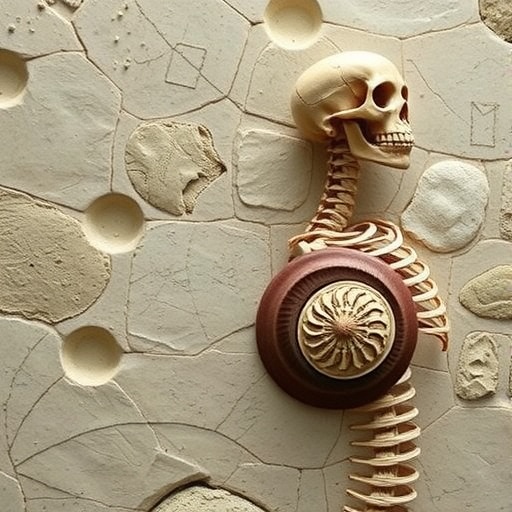The dawn of skeletons in the animal kingdom traces back over half a billion years to the early Cambrian Period, approximately 538 to 506 million years ago. During this transformational interval, a pivotal evolutionary milestone occurred as multiple major animal groups independently developed mineralized skeletons or shells. This innovation was critical for survival, providing structural support and protection. Predominantly, these organisms employed one of two mineralization strategies: the first involved the construction of mineral tissues atop an organic scaffold—a process reminiscent of modern vertebrate bone and tooth formation. Alternatively, some gathered environmental minerals, binding them with organic materials to form protective external coatings. Remarkably, these foundational mechanisms, once established, demonstrated evolutionary persistence, with lineages conserving these strategies across more than 540 million years.
One organism, however, challenges this evolutionary orthodoxy: Salterella. Fossilized remains of this enigmatic creature are abundant in early Cambrian sediments and serve as crucial index fossils, enabling precise geological dating and stratigraphic correlation. Salterella’s architecture defies the conventional dichotomy by exhibiting both mineralized shell and internal mineralized lining, a combination scarcely observed elsewhere in the fossil record. This dual mineralization suggests a complex biological innovation, where a conical external shell encases the body, while the inner cavity is densely packed with selectively acquired minerals, creating a compact inner shell layer with unique structural properties.
The peculiar biological construct of Salterella has long perplexed paleontologists, complicating efforts to accurately place it within the tree of life. Initial classifications oscillated wildly—from molluscan relatives such as squids and octopuses to opisthobranchs akin to sea slugs, and even more distantly related groups like jellyfish and worms, reflecting the organism’s unusual morphology and uncertain affinities. By the 1970s, researchers responded to this taxonomic confusion by erecting a novel category encompassing Salterella alongside Volborthella, a similarly mystifying fossil exhibiting comparable shell structures. Yet, despite this taxonomic innovation, their evolutionary narratives remained disconnected, shrouded in mystery.
Prescott Vayda, a geosciences graduate student, embarked on a comprehensive investigation to decode Salterella’s biological and evolutionary significance. Collaborating with established experts including University Distinguished Professor Shuhai Xiao and colleagues from prestigious institutions like Johns Hopkins University, Dartmouth College, the University of Missouri, and the Denver Museum of Nature and Science, Vayda undertook an integrative approach. This involved meticulous field collection spanning diverse locales—from the arid basins of Death Valley and the frigid expanses of Yukon, Canada, to the richly fossiliferous rocks of Wythe County, Virginia. Advanced analytical methods probed Salterella’s morphology, mineralogical composition, and crystallographic features with unprecedented granularity.
Their findings revealed that Salterella’s mineral selection process was far from arbitrary. The organism demonstrated discernment, rejecting certain minerals such as clays while preferentially incorporating quartz and notably favoring titanium—a mineral prized for its exceptional durability and strength. This selective uptake implies sophisticated biological control mechanisms, possibly linked to enhancing shell robustness or fulfilling ecological functions like feeding stability. The researchers further inferred that Salterella must have possessed specialized appendages capable of mineral gathering, a biological complexity previously unrecognized.
Such mineralogical specificity and dual shell construction illuminate aspects of Salterella’s life history that had remained obscure. The internal mineral lining may have played critical roles in mechanical reinforcement or metabolic processes, while the conical outer shell provided environmental shielding. These discoveries not only reconstruct a more vivid image of Salterella’s biology but also inform broader evolutionary contexts regarding organismal strategies for skeletal development—a key facet of animal evolution.
Integrating evidence from shape analysis, ecological context, and detailed shell ultrastructure, the research consortium proposed a revised phylogenetic placement. Salterella and Volborthella exhibit traits aligning them with the Cnidaria—a diverse and ecologically vital phylum comprising modern corals, jellyfish, and sea anemones. This affiliation reorients our understanding of early animal evolution, indicating that complex mineralized skeletons may have evolved within cnidarians, or at least that their ancestors experimented with novel biomineralization strategies.
By restoring these fossil groups to their rightful phylogenetic context, the study bridges substantial gaps in evolutionary theory, suggesting that the origins of protective shells and internal skeletons are more intricate and varied than previously appreciated. The work underscores the evolutionary plasticity of biomineralization pathways, potentially informing biomimetic designs and shedding light on the adaptive pathways that shaped early metazoan diversification.
Vayda emphasizes the profound significance of this research beyond paleontological curiosities. “Understanding where we come from—tracing the intricate history of life on Earth—is both an amazing and beautiful pursuit,” he reflects. Such insights not only enrich scientific knowledge but also resonate with broader questions about life’s resilience and the evolutionary ingenuity that shaped the biological world.
The study published in the Journal of Paleontology marks a milestone in unraveling the complex evolutionary narrative of early skeletal animals. By situating Salterella and Volborthella within the cnidarian lineage, it challenges existing paradigms, prompts reevaluation of fossil classifications, and inspires fresh inquiries into Cambrian biodiversity and the genesis of biomineralization. As paleontologists continue to uncover and analyze these ancient life forms, the story of skeleton evolution gains new depth and texture, embodying the dynamic interplay between biology, geology, and chemistry that forged Earth’s primordial ecosystems.
In summary, this groundbreaking research illuminates Salterella’s unique dual mineralization strategy, its selective mineral incorporation—highlighting preferences for titanium—and reaffirmed phylogenetic placement within cnidarians. It transforms a puzzle fragment of the Cambrian fossil record into a vital key for understanding animal skeletal evolution, revealing an unexpected lineage linkage and providing a springboard for future exploration of early metazoan life.
Subject of Research: Evolution of mineralized skeletons and shells in early Cambrian organisms, specifically the biological and phylogenetic characterization of Salterella and Volborthella.
Article Title: A Cnidarian affinity for Salterella and Volborthella: implications for the evolution of shells
News Publication Date: 13-October-2025
Web References: https://doi.org/10.1017/jpa.2025.10164
Image Credits: Photo by Spencer Coppage for Virginia Tech.
Keywords: Paleontology, Fossils, Microfossils, Index fossils, Early Cambrian, Biomineralization, Cnidaria, Evolutionary biology, Skeleton evolution, Salterella, Volborthella, Mineral selection




